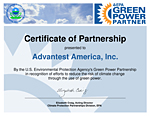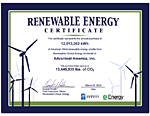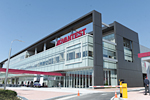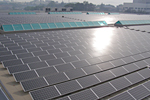 웹 내용 전시
웹 내용 전시

Basic Policy
The Advantest Group regards its efforts toward putting a stop to global warming as part of the corporate mission, and as such works vigorously to reduce greenhouse gas emissions by offering green products and introducing innovative business processes.
The Advantest Group is pursuing medium- to long-range energy conservation measures in alignment with the Japanese government's medium-term goal of reducing greenhouse gas emissions by 25% of 1990 levels by 2020. More urgently, the Group is forging a system to address Japan's revised Act on the Rational Use of Energy and related ordinances, and accordingly implement energy conservation measures.
Fiscal 2013 results
Advantest is working to simultaneously achieve both energy savings and cost reduction through more efficient production and elimination of waste. In our buildings, we are optimizing air-conditioning and other systems and replacing superannuated equipment with more efficient models, as well as implementing appropriate lighting levels and switching to LED illumination. Our major initiatives in fiscal 2013 were to introduce high-efficiency transformers and optimize air-conditioning, for annual savings of approximately 62 MWh. Nevertheless, due to an increase in the CO2 conversion coefficient for electricity, Advantest's domestic CO2 emissions actually increased.
From the viewpoint of eliminating waste, we will continue our efforts to reduce CO2 emissions and thereby achieve both energy savings and cost reduction.
CO2 emission and CO2 emissions per unit of production
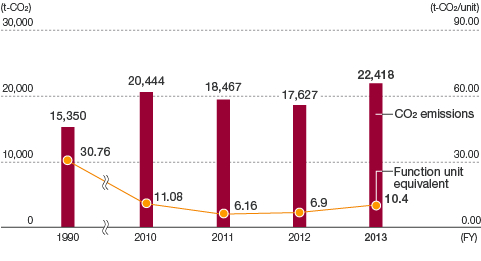
Low-energy operations in clean rooms
Air-conditioning of clean rooms (CR) accounts for about 70% of all electricity use at Advantest Component, Inc. (ACI). Since fiscal 2010, we have implemented various power conservation measures, but electricity price hikes necessitated additional efforts on our part.
In fiscal 2013, we adopted the slogan of "power conservation without capex" and began considering, experimenting, and verifying conservation measures at team meetings based on ACT2014 activities. New policies emerged and were implemented. One was to set the CR temperature at 25 degrees C in the Jul-Sep period to achieve summer power savings. In winter, we optimized the air-conditioning chiller* and implemented draft-exhaust volume restriction on non-business days*, thus achieving year-round savings. Energy awareness has risen within ACI, and when further energy saving ideas were solicited from employees, about 60 proposals were submitted, which have given rise to further savings.
As a result of these efforts, ACI has reduced its electricity consumption by 1,050 MWh compared to fiscal 2009 (16%).
Our employees will continue their energy conservation efforts and make new proposals in the future, allowing us to cut energy consumption even more.
* Note 1: Optimization of air-conditioning chiller
In winter, ACI's clean rooms require warm water for temperature and humidity adjustments. Setting the water temperature, volume, and pressure at the lowest practicable levels reduced the need for chiller and pump use, and thus reduced electricity consumption. In fact, all settings cannot be controlled automatically, so while monitoring changes in the ambient dew point and heat emission in the clean room, employees finely adjusted the preheat temperature for air intake each day, saving electricity that way.
* Note 2: Draft-exhaust volume restriction on non-business days
By closing the front door of the draft* used in chemical processing, exhaust volume is reduced to the lowest practicable volume, which in turn reduces electricity use for air-conditioning. Since air intake declines along with exhaust volume, electricity for temperature and humidity adjustment of the air intake, as well as for the air-supply and exhaust fans, is also reduced. However, it takes time to open and close the front door of the draft without causing fluctuations in clean room pressure, so this method is applied only on non-business days.
* Note 3:
A working surface equipped with a disposal function. It is used in clean rooms to absorb and expel noxious gasses, chemical dust, and other dust that could affect human health.
Key Measures and Results
| Main Policies | Electricity Reduction Achieved (MWh) |
|---|---|
| Continuation of past energy conservation measures | 520 |
| Green room set to 25℃ (normally 23℃) | 320 |
| Cool-water secondary pump pressure reduced | |
| Winter setting of chiller optimized | 130 |
| Clean room airflow set to minimum for New Year's holidays | 20 |
| Draft exhaust flow restricted on non-business days (from February) | 20 |
| Compressed air pressure lowered | 10 |
| Others | 30 |
| Total electricity reduction | 1,050 |
| Change from fiscal 2009 (target 13%) | 16% |
Electricity Consumption Sendai Factory A Building
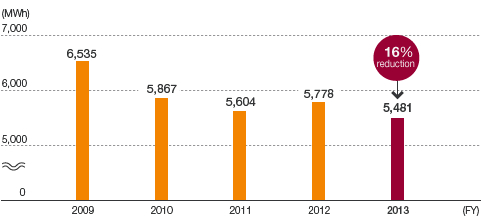
Lower CO2 emissions through air conditioning upgrades
At the Gunma R&D Center, we have upgraded our meeting room heating equipment by applying inverter technology to existing pumps while adding heat exchangers designed to draw on steam for heat generation. As a result, the entire facility's heating systems now operate more efficiently by steadily raising water temperatures and reducing power consumption.
Furthermore, we uncovered inefficiencies in some freeze prevention control systems of outdoor air conditioning units, and consequently reduced cold water and hot water heat source loads by adjusting hot water valve openings down to 10%, from 50% previously.
These improvements overall have enabled us to slash the facility's annual power consumption by an equivalent of more than 50 kiloliters of oil, while cutting yearly CO2 emissions by more than 135 tons.
Green electricity initiatives at overseas bases
Purchase of wind-generated green electricity
Advantest America, Inc. (AAI) is committed to the use of renewable energy. To reduce the environmental impact of its electricity consumption, AAI makes do with 100% wind-generated electricity at its facilities. The EPA* presented AAI with a Green Power Award 2013 for this initiative, which began in November 2013.
* EPA: United States Environmental Protection Agency
Certification
Installation of large-scale solar power panels
Advantest Korea Co., Ltd. (ATK) has proceeded with various environmental activities. It has installed solar power panels on the spacious roofs of its head office and factory, generating approximately 1,325 MWh annually, filling about 20% of ATK's electricity needs. In other initiatives, ATK divides waste materials into narrowly defined categories for recycling, and the Company is promoting a "clean your plate" campaign to eliminate leftovers in the cafeteria.
solar power panels

